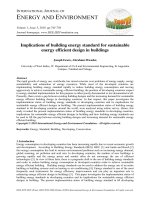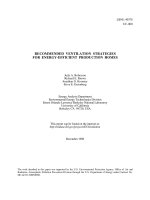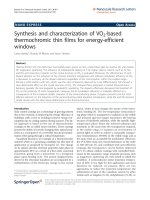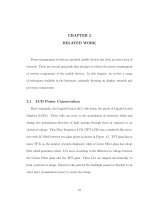Energy efficient cooperative communicati
Bạn đang xem bản rút gọn của tài liệu. Xem và tải ngay bản đầy đủ của tài liệu tại đây (678.07 KB, 5 trang )
2011 International Conference on Advanced Technologies for Communications (ATC 2011)
Energy efficient cooperative communication
techniques for Intelligent Transport System
Tuan-Duc Nguyen∗ , Quoc-Bao Vo-Nguyen† ,Minh-Thanh Vo∗ , Linh Mai∗
∗ International
† Post
University of Vietnam National University, Vietnam
Email:
and Telecommunication Institute of Technology, Vietnam
Email:
energy constrained device like road infrastructure to a vehicle
(I2V) or to another energy constrained device (I2I). In traditional approach, multi-hop transmission technique is used to
reduce the transmission energy consumption by dividing the
long transmission channel into multiple short transmissions.
The cooperative relay technique can exploit the spatial and
temporal diversity gain in order to increase system performance or reduce transmission energy. Relay techniques have
been known as a simple and energy efficient technique to
extend the transmission range due to their simplicity and their
performance for wireless transmissions over fading channels
[1], [2] and [3]. Not only the relay technique, the cooperative
MIMO technique can also exploit the diversity gain of spacetime coding technique to increase the system performance
or to reduce the energy consumption. In cooperative MIMO
communication, some individual wireless nodes can cooperate
at the transmission and the reception in order to deploy a
Multi-Input Multi-Output (MIMO) transmission using space
time block codes [4], [5], [6].
Cooperative MIMO technique has been proposed because
the nodes embedded in the road signs can not have more than
one antenna because of the limitations in space and cost. In
[7] [8], it has been shown that cooperative MISO and MIMO
systems are more energy-efficient than Single-Input SingleOutput (SISO) and traditional multi-hop SISO systems for
medium and long range transmission in wireless distributed
sensor networks. One the other hand, cooperation between
nodes can also help to extend the transmission range (with
the same output power of one wireless node), thus increasing
the communication distance between two nodes or two groups
of nodes.
In this paper, these three cooperative techniques are proposed for I2V and I2I cooperative transmissions. The context
of the study is the low power wireless transmissions between
Infrastructure and Vehicles, where the network composed
of wireless nodes at a junction has to give to the arriving
vehicles short term information for driving assistance and long
term information for traffic management. Paper show that
the cooperative MIMO and relay techniques are better than
the Single-Input Single-Output (SISO) and SISO multi-hop
technique in terms of performance and energy consumption.
Abstract—In wireless distributed networks, cooperative relay
and cooperative Multi-Input Multi-Output (MIMO) techniques
can be used to exploit the spatial and temporal diversity gain
in order to increase the performance or reduce the transmission
energy consumption. The energy efficiency of cooperative MIMO
and relay techniques is then very useful for the Infrastructure
to Vehicle (I2V) and Infrastructure to Infrastructure (I2I) communications in Intelligent Transport Systems (ITS) networks
where the energy consumption of wireless nodes embedded on
road infrastructure is constrained. In this paper, applications
of cooperation between nodes to ITS networks are proposed and
the performance and the energy consumption of cooperative relay
and cooperative MIMO are investigated in comparison with the
traditional multi-hop technique. The comparison between these
cooperative techniques helps us to choose the optimal cooperative
strategy in terms of energy consumption for energy constrained
road infrastructure networks in ITS applications.
I. I NTRODUCTION
In future Intelligent Transport Systems (ITS), information
and communication from the road infrastructure to vehicle
(I2V) will play a key role in driving assistance, floating car
data, and traffic management in order to make the road safer
and more intelligent. The communications are supported by
wireless nodes integrated in road signs (or traffic infrastructure
along the road) and vehicles. While wireless nodes embedded
in vehicles can take profit from their battery or can be regularly
recharged, each road sign wireless node is usually powered by
a small battery that may not be rechargeable or renewable for
long term (or powered by a low power solar battery). Even if
such networks are mainly concentrated in cities (even though
new applications appear for rural junctions too), many of the
nodes are not necessarily connected to electrical power supply,
due to the civil engineering cost. The energy consumption of
road infrastructure wireless nodes is consequently one of the
important constraints in order to increase the reliability and
the lifetime of this network.
As the transmission power increases quickly as a power
function K of the transmission distance (with typical path loss
factor 2 < K < 6), the transmission energy consumption plays
an important role for medium and long range transmission and
represents the dominant part of the total energy consumption.
In some ITS applications, the energy efficient transmission
technique is very important for the communication from an
978-1-4577-1207-4/11/$26.00 ©2011 IEEE
76
Both techniques are interesting in the energy constrained ITS
applications and the advantages of each technique depends on
the particular network structure or on the application.
The rest of the paper is organized as follows. Cooperative
communication strategies for the energy consumption optimization in ITS are presented in Section II. In Section III, the
energy calculation model is proposed and simulation results on
the energy consumption comparison of cooperative techniques
are presented in Section IV. Finally, conclusions and discussion
are given in Section V.
B. Relay transmission
In Fig.2, a message from the road sign can be transmitted
to the vehicle (destination node D) and another road sign
(relay node R). Then, the message is relayed from this relay
road sign to the vehicle for signal combination. Transmission
diversity gain of relay technique helps to decrease the transmission power for the same error rate requirement, so that
reduce the transmission energy consumption. This technique is
more energy efficient than multi-hop SISO for medium range
transmission.
II. C OOPERATIVE T RANSMISSIONS IN ITS
In the wireless ITS, information is transmitted, thanks to
vehicles and existing infrastructure, within a network whose
typical size is metropolitan. The communications can occur
from road infrastructure to vehicle (I2V), road infrastructure to
road infrastructure (I2I), vehicle to road infrastructure (V2I) or
a vehicle to vehicle (V2V). The energy constraint for road sign
infrastructure is very important due to the fact that batteries
in traffic road signs can not be replaced for a long time.
In plenty of communication scenarios in ITS, the transmission between the infrastructure and the vehicles are usually
from a medium to long distance and a direct transmission,
if possible, would need too much transmission energy. A
traditional multi-hop routing technique can be used for such
transmissions but it is not efficient enough in terms of energy
consumption in many cases. By exploiting the diversity transmission to reduce the transmission energy consumption, relay
and cooperative MIMO techniques are the better strategies in
terms of energy efficiency.
Considering that the circle and the rectangle stand respectively for the road sign and the vehicle in the transport
system, some cooperative transmission strategies, illustrated
in Fig. 1 to Fig. 4 , have been proposed for energy efficiency
transmissions in ITS communication.
S
D
R
Fig. 2.
Relay transmission between infrastructure and vehicle
C. Cooperative MIMO transmission
Cooperative MIMO technique is an energy efficient cooperative technique for medium and long range transmission
[8]. Cooperative MIMO technique exploits the diversity gain
of the MIMO space-time coding technique in distributed
wireless networks in order to reduce the transmission energy
consumption. Depending on the system topology (the available
nodes) and the transmission distance, the optimal selection of
transmit and receive nodes number can be chosen in order to
minimize the total energy consumption.
A. SISO multi-hop transmission
The most simple cooperation scheme is the multi-hop SISO
transmission, as shown by Fig. 1. Instead of the transmission
over a long distance from source node S to the destination
node D, a message from a road sign (source node S) at a
junction can be transmitted through multiple road signs (cooperation nodes) to a vehicle (destination node D). Multi-hop
transmission can save significantly the transmission energy
consumption with the cost of more circuit energy consumption.
S
mission
D
Fig. 3.
Cooperative MISO transmission between infrastructure and vehicle
As illustrated on Fig. 3, a road sign node S can cooperate
with its neighbor road signs to employ a cooperative MISO
(Multiple Input Single Output) technique to transmit a message
to the vehicle (destination node D).
An example of cooperative MIMO transmission is shown in
Fig. 4, where the road sign node S can cooperate with other
road signs in one crossroad to transmit the message by using
a cooperative MIMO technique to the cooperative reception
road signs in the other crossroad.
S
D
Fig. 1.
MISO T
rans
Multi-hop SISO transmission between infrastructure and vehicle
77
S
MIMO Transm
fc = 2.5 GHz
Gt Gr = 5 dBi
B = 10 Khz
Pmix = 30.3 mW
P¯b = 10−3
Pf ilt = Pf ilr = 2.5 mW
Nf = 10 dB
D
ission
η = 0.35
= −174 dBm/Hz
β=1
Psyn = 50 mW
1
Ts = B
PLN A = 20 mW
ML = 40 dB
σ2 =
N0
2
TABLE I
S YSTEM
Fig. 4. Cooperative MIMO transmission between infrastructure and infrastructure
tude at the receiver and makes it more difficult to estimate the
Channel State Information (CSI).
In the presence of transmission synchronization error, the
orthogonal combination of space time codes can not be performed, which leads to the amplitude decrease of the desired
signal and generates more interferences in final estimated
symbols [9] [10].
The performance degradation increases with the transmission synchronization error range. The cooperative MIMO
system is rather tolerant for small range of transmission
synchronization error. For small transmission synchronization
error ranges, the performance degradation is small enough to
keep the energy efficiency advantage of cooperative MIMO
system over SISO and multi-hop SISO techniques. However,
the performance degradation become significant for a large
transmission synchronization errors. In this case, a more
complex distributed space time code or a efficient spacetime combination technique can be used in order to retain
the performance of cooperative MIMO in the presence of
transmission synchronization error [11].
III. P ERFORMANCE COMPARISON OF COOPERATIVE
TECHNIQUES
As the cooperative relay and cooperative MIMO technique
can exploit the diversity gain to increase the performance,
the performance of both techniques is much better than the
SISO technique and the needed Signal-to-Noise Ratio (SNR)
is smaller for the same error rate requirement. Fig. 5 represents
the Frame Error Rate (FER) performance comparison of the
relay (Decode-and-Forward and Amplify-and-Forward techniques) and the cooperative MISO techniques for two transmit
nodes with the traditional SISO technique.
SISO
coop 2−1
Amplify and Forward
Decode and Forward
−1
FER
10
PARAMETERS FOR THE ENERGY CONSUMPTION EVALUATION .
−2
10
IV. E NERGY E FFICIENCY OF C OOPERATIVE S TRATEGIES
For energy consumption estimation, evaluation and comparison purposes, the reference energy model in [12] with the
system parameters in Table I is used in this paper. More details
on the energy consumption calculation using this reference
model can be consulted in [8]. The following figures represent
the total energy consumption to transmit 107 bits with the error
rate requirement F ER = 10−3 from a source node S to a
destination node D separated by a distance d (over a Rayleigh
fading channel). The local distance between cooperative nodes
in cooperative MIMO techniques is dm = 5m and the sourcerelay distance d1 in relay techniques is equal to d/3.
−3
10
10
15
20
25
SNR (dB)
30
35
40
Fig. 5. FER of relay technique vs. cooperative MISO technique with two
transmission nodes, non-coded QPSK modulation over a Rayleigh channel,
120 bits/frame, source-relay distance d1 = d/3, and power path-loss factor
K=2.
As needed SNRs of the cooperative MISO and relay
techniques are smaller than the SISO technique, the two
cooperative techniques can help to reduce the transmission
energy consumption for the same transmission reliability in an
energy constrained traffic-signs wireless network. This energy
efficiency of cooperative MIMO and relay techniques is very
useful for a typical medium to long distance transmission in
ITS application where the transmission energy consumption
dominates the total consumption of a wireless node.
Since the nodes are physically separated in a cooperative
MIMO system, their different respective clocks lead to desynchronized transmission and reception. That generates InterSymbol Interference (ISI), decreases the desired signal ampli-
A. Multi hop SISO vs. cooperative MISO Techniques
The energy consumption comparison between multi-hop
SISO and the cooperative MISO is presented on Fig. 6 with
the optimal hop distance of the multi-hop SISO dhop = 25m.
At the transmission distance d = 100m (4 hops), the multihop technique can save 53% of the total energy consumption
of the SISO system.
Multi-hop technique is more efficient than SISO transmission. However, the multi-hop SISO system is 69% less energyefficient than the cooperative 2-1 MISO system. At distance
d = 100m, 85% energy is saved by using 2-1 cooperative
MISO transmission instead of SISO. One should note that
78
6
3
SISO N=1 M=1
coop MISO N=2 M=1
multi−hop SISO
2.5
Total Energy (mJ)
fixed, the transmission energy consumption depends on the
required energy per bit Eb and the power path-loss factor
of the channel. If the required error rate F ER increases
(less reliable transmission), the required SNR and transmission energy consumption will decrease, reducing the energy
efficiency advantage of the cooperative MIMO over SISO and
SISO multi-hop techniques. Otherwise, if the path-loss factor
K increases (e.g. in a urban environment), the transmission
energy consumption increases quickly (as a power function of
the path-loss factor K). As cooperative MIMO technique helps
to reduce efficiently the transmission energy, the advantage
of cooperation increases. As far as the frequency band is
concerned, if the frequency fc = 5.8GHz (which was elected
by the European Union for ITS applications and is used in Delicate Short Range Communication technology) is considered
instead of a reference model frequency 2.5GHz used in this
K
paper, the transmission energy consumption increases ( 5.8
2.5 )
times, and the cooperative MIMO technique will probably be
more efficient.
x 10
2
1.5
1
0.5
0
10
20
30
40
50
60
Distance (m)
70
80
90
100
Fig. 6. Energy Consumption of SISO vs. cooperative MISO technique with
two transmission nodes, power path-loss factor K = 2, F ER = 10−3 ,
Rayleigh fading channel.
B. Cooperative MISO vs. Relay Techniques
the total energy consumption is the consumption of all nodes,
not only one source node. 69% or 85% is the total energy
saving for the whole network by using cooperative techniques.
The transmission energy consumption (which is always greater
than reception energy consumption for long distance) is shared
by all cooperative transmission nodes. Moreover, as the multihop system needs four hops for signal transmission to the
destination node, the transmission delay of the multi-hop
technique is much more than the cooperative MISO technique
which cost typically two phases of transmission.
The performance of relay techniques is limited by the
decoding (or signal processing) process at the relay nodes.
The error bit (or amplification noise) occurring at the relay
node can not be always corrected at the destination node.
Although with the same diversity gain, the performance of relay is always lower than MISO space time coding techniques.
Therefore, in many cases, the total energy consumption of the
relay technique is higher than the cooperative MISO technique.
Fig. 8 shows the energy consumption of relay technique in
comparison with SISO technique and cooperative MISO 2-1
technique.
6
2.4
x 10
2.2
2
N=2 M=1
N=3 M=1
N=4 M=1
6
3.5
SISO
coop MISO
Relay Decode−Forward
3
1.6
2.5
1.4
Total Energy (mJ)
Total Energy (mJ)
1.8
x 10
1.2
1
0.8
1.5
1
0.6
0.4
100
2
150
200
250
Distance (m)
300
350
0.5
400
0
10
Fig. 7. Energy Consumption of cooperative MISO technique with two, three
and four transmission nodes, power path-loss factor K = 2, F ER = 10−3 ,
Rayleigh fading channel.
20
30
40
50
60
Distance (m)
70
80
90
100
Fig. 8.
Energy Consumption of relay technique vs. cooperative MIMO
technique with two transmission nodes, error rate F ER = 10−3 , power
path-loss factor K = 2, source-relay distance d1 = d/3.
As the performance gain increases with the number of cooperative transmission nodes in cooperative MIMO techniques,
the cooperative MISO 3-1 or MISO 4-1 is more efficient than
the cooperative MISO 2-1 or MISO 3-1 at d = 180m or
d = 300m respectively as shown in Fig. 7.
If all the RF parameters and the transmission distance are
However, in the presence of transmission errors, the performance of cooperative MISO technique decreases which
leading to the increase of transmission energy consumption.
For a small synchronization error range, the degradation is
79
negligible but it becomes significant for a large error range,
leading to a more required transmission energy [10]. The
advantage of relay technique over cooperative is that relay
is not affected by the un-synchronized transmission. Fig. 9
shows the energy consumption comparison of cooperative 2-1
and relay techniques with the path loss factor K = 3 and the
transmission synchronization error range ∆Tsyn is as large as
0.5Ts . In this condition, the relay is clearly better than the
cooperative MISO in terms of energy consumption.
can be exploited to reduce the transmission energy consumption. Relay techniques is less efficient than cooperative
MISO techniques in terms of energy consumption. because the
performance of relay techniques is not as good as cooperative
MISO techniques for the same SNR. However, relay techniques are not affected by the un-synchronized transmission
scheme of distributed cooperative wireless network. When
the transmission synchronization error becomes significant,
the performance of relay is better than the performance of
cooperative MISO, leading to a better energy efficiency.
7
6
x 10
R EFERENCES
coop MISO ∆ Tsyn=0.5Ts
Relay D−F K =3
5
Total Energy (mJ)
[1] J. Laneman and G. Wornell, “Energy-efficient antenna sharing and
relaying for wireless networks,” in IEEE Wireless Communications and
Networking Conference, WCNC, vol. 1, 2000.
[2] A. Sendonaris, E. Erkip, and B. Aazhang, “User cooperation diversity.
Part I. System description,” IEEE Transactions on Communications,
vol. 51, no. 11, pp. 1927–1938, 2003.
[3] J. Laneman, D. Tse, and G. Wornell, “Cooperative diversity in wireless
networks: Efficient protocols and outage behavior,” IEEE Transactions
on Information Theory, vol. 50, no. 12, pp. 3062–3080, 2004.
[4] M. Dohler, E. Lefranc, and H. Aghvami, “Space-time block codes for
virtual antenna arrays,” in The 13th IEEE International Symposium on
Personal, Indoor and Mobile Radio Communications, vol. 1, 2002.
[5] X. Li, “Energy efficient wireless sensor networks with transmission
diversity,” Electronics Letters, vol. 39, p. 1753, 2003.
[6] J. Laneman and G. Wornell, “Distributed space-time-coded protocols
for exploiting cooperative diversity in wireless networks,” IEEE Transactions on Information Theory, vol. 49, no. 10, pp. 2415–2425, 2003.
[7] S. Cui, A. Goldsmith, and A. Bahai, “Energy-efficiency of MIMO and
cooperative MIMO techniques in sensor networks,” IEEE Journal on
Selected Areas in Communications, vol. 22, no. 6, pp. 1089–1098, 2004.
[8] T. Nguyen, O. Berder, and O. Sentieys, “Cooperative MIMO schemes
optimal selection for wireless sensor networks,” IEEE 65th Vehicular
Technology Conference, VTC-Spring 07, pp. 85–89, 2007.
[9] S. Jagannathan, H. Aghajan, and A. Goldsmith, “The effect of time synchronization errors on the performance of cooperative MISO systems,”
in IEEE Global Telecommunications Conference Workshops, GlobeCom
Workshops 2004, 2004, pp. 102 – 107.
[10] T. Nguyen, O. Berder, and O. Sentieys, “Impact of Transmission
Synchronization Error and Cooperative Reception Techniques on the
Performance of Cooperative MIMO Systems,” IEEE International Conference on Communications, ICC Beijing, pp. 4601–4605, 2008.
[11] ——, “Efficient Space Time Combination Technique for Unsynchronized Cooperative Miso Transmission,” IEEE Vehicular Technology
Conference, VTC Spring 2008, pp. 629–633, 2008.
[12] S. Cui, A. J. Goldsmith, and A. Bahai, “Modulation optimization under
energy constraints,” in IEEE International Conference on Communications, Anchorage, AK, USA, May 2003, pp. 2805 – 2811.
4
3
2
1
0
10
20
30
40
50
60
Distance (m)
70
80
90
100
Fig. 9.
Energy consumption of relay technique vs. cooperative MISO
technique with two transmission nodes N = 2, power path-loss factor
K = 3, error rate F ER = 10−2 , transmission synchronization error range
∆Tsyn = 0.5Ts and source-relay distance d1 = d/3.
In the case that the number of cooperative transmission
nodes N is greater than two (e.g. three or four transmit nodes),
the relay technique typically needs N transmission phases to
transmit all signals from N − 1 relay nodes to the destination
node (if orthogonal frequency channels are not considered).
But a cooperative MISO technique needs typically 2 transmission phases (data exchange and MISO transmission phases).
The transmission delay of the relay technique is longer than
the cooperative MISO technique. However, the complexity of
the relay is less than the cooperative MISO.
V. C ONCLUSION
Cooperative techniques can exploit the transmission diversity gain in order to increase the performance or to reduce
the transmission energy consumption of the system. Some
cooperative strategies, based on the multi-hop, cooperative
relay and cooperative MIMO techniques, have been proposed
in order to deploy energy efficient transmissions between the
road infrastructures and vehicles in ITS.
In this paper, it is shown that relay and cooperative MISO
(and cooperative MIMO) techniques are more energy-efficient
than SISO and traditional multi-hop SISO techniques for
medium and long range transmissions.
Relay techniques provide attractive benefits for wireless
distributed systems when the temporal and spatial diversity
80









